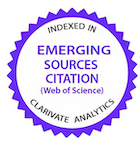Artérias dos lobos torácicos do timo em fetos de suínos da linhagem Camborough 22
DOI:
https://doi.org/10.5216/cab.v12i4.3365Palavras-chave:
Suínos, timo, artérias.Resumo
O estudo teve como objetivo retratar os aspectos morfológicos particulares apresentados pelas artérias responsáveis pelo suprimento sanguíneo do timo em fetos de suínos da linhagem Camborough 22. Para tanto, as origens e distribuições das artérias que vascularizaram os lobos torácicos do timo, direito e esquerdo, foram estudadas em 30 fetos suínos, 15 machos e 15 fêmeas, da linhagem Camborough 22. Os exemplares tiveram o sistema arterial preenchido com solução aquosa a 50% de Neoprene Látex corado, através da parte descendente da aorta torácica, e em seguida foram submetidos à fixação em solução aquosa, a 10%, de formaldeído. Os lobos torácicos do timo eram irrigados pelos ramos diretos das artérias torácica interna direita (40%) e esquerda (30%) e cervical superficial esquerda (3,33%). O tronco bicarótico (3,33%) contribuiu com ramos diretos para o lobo torácico esquerdo do timo. As artérias torácica interna direita (66,67%) e esquerda (50%), subclávia direita (6,67%) e esquerda (6,67%), cervical profunda direita (3,33%) e escapular dorsal esquerda (3,33%) emitiram ramos indiretos para os correspondentes lobos torácicos do timo em cada antímero. Os troncos braquiocefálico (13,33%) e bicarótico (6,67%) cederam ramos indiretos para o lobo torácico do timo, do mesmo antímero. Não foram evidenciadas diferenças significativas em relação às origens das artérias, os tipos de ramos e o sexo dos animais em relação ao antímero do lobo tímico que foi vascularizado.
ALAVRAS-CHAVE: artérias; morfologia; órgãos linfóides; timo; vasos sanguíneos.
Downloads
Publicado
Como Citar
Edição
Seção
Licença
Copyright (c) 2011 Ciência Animal Brasileira / Brazilian Animal Science

Este trabalho está licenciado sob uma licença Creative Commons Attribution 4.0 International License.
Autores que publicam nesta revista concordam com os seguintes termos:
- Autores mantém os direitos autorais e concedem à revista o direito de primeira publicação, com o trabalho simultaneamente licenciado sob a Licença Creative Commons Attribution que permite o compartilhamento do trabalho com reconhecimento da autoria e publicação inicial nesta revista.
- Autores têm autorização para assumir contratos adicionais separadamente, para distribuição não-exclusiva da versão do trabalho publicada nesta revista (ex.: publicar em repositório institucional ou como capítulo de livro), com reconhecimento de autoria e publicação inicial nesta revista.
- Autores têm permissão e são estimulados a publicar e distribuir seu trabalho online (ex.: em repositórios institucionais ou na sua página pessoal) a qualquer ponto antes ou durante o processo editorial, já que isso pode gerar alterações produtivas, bem como aumentar o impacto e a citação do trabalho publicado (Veja O Efeito do Acesso Livre).






























